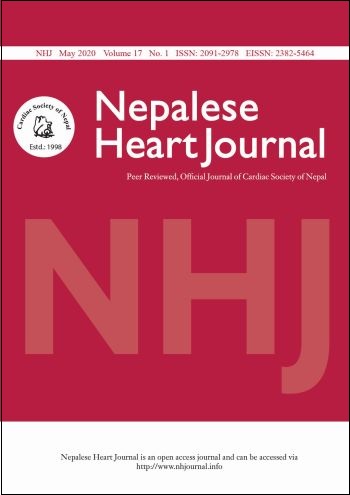Comparative study between the use of St. Thomas' II cardioplegia and del Nido cardioplegia in patients who underwent open-heart surgery
DOI:
https://doi.org/10.3126/njh.v17i1.28802Keywords:
del Nido solution, St Thomas' II Solution, Cardioplegia Myocardial ProtectionAbstract
Background and Aims: Cardioplegia is used to arrest the heart after the application of an aortic cross-clamp that interrupts the coronary circulation. Commonly used St. Thomas’II cardioplegic solution has to be repeated at short intervals, which may cause additional myocardial injury. So, this study is done to determine whether del Nido (DN) cardioplegia, which has a longer duration of arrest with a single dose, provides equivalent or better myocardial protection as compared to St. Thomas’ II Cardioplegia.
Methods: A prospective observational study was done among 100 patients who underwent open-heart surgery with myocardial protection, between September 2016 to August 2018 in Bangabandhu Sheikh Mujib Medical University, Bangladesh. Patients were divided into two groups, group A (n=50) for del Nido cardioplegic and group B (n=50) for St. Thomas’ II cardioplegia. We compared the amount of cardioplegic solution, Aortic cross-clamp time, cardiopulmonary bypass (CPB) time, ischemic time, arrhythmia, spontaneous sinus rhythm after declamping, intraoperative DC shock requirement, postoperative left ventricular ejection fraction, serum potassium level, low cardiac output, cardiac Troponin level I and CK-MB release after 12 hours and 24 hours, presence of myocardial infarction and death.
Results: The per-operative variable suggested spontaneous activity during a cardiac arrest was 2% in del Nido and 14% in St. Thomas’ II group (p=0.044). Similarly, during intraoperative phase spontaneous restoration of cardiac activity after the procedure in del Nido was 2.90 ± 1.16 minutes and in St. Thomas’ II was 1.8 ± 0.615 minutes (p=0.001). However total bypass time and ischemic time were not significant. During the postoperative period, Troponin I and CKMB were measured at 12 hours and 24 hours which were not statistically different in two groups. Postoperatively, low output syndrome was seen among 3 patients in del Nido Group and 4 patients in St. Thomas’ II group (p-value=0.341).
Conclusion: This study showed with the use of del Nido cardioplegia provides equivalent myocardial protection to St. Thomas’ II cardioplegia, with the use of only single-dose cardioplegia.
Downloads
Downloads
Published
How to Cite
Issue
Section
License
This license enables reusers to distribute, remix, adapt, and build upon the material in any medium or format, so long as attribution is given to the creator. The license allows for commercial use.




